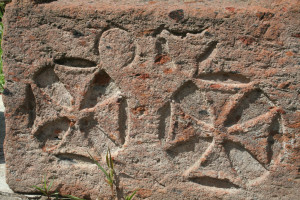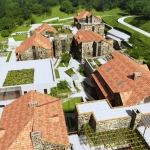
The 11th century in the cultural life of medieval Armenia is significant for the creation of both architectural and pictorial monuments. A large number of valuable and interesting works of artistic illustration of books were created in different regions of Armenia according to the peculiar features of each region. The school of Ani is unique in the Armenian medieval miniature art of the 11th century for one of its best works – the Gospel of Mughni.
The Gospel has 10 altars, images of 4 evangelists and 11 plot miniatures covering the whole page. The painting of the Gospel of Mughni stands out by the monumental organization of scenes and the architectural inclusion of still landscape painting in the background of which the massive representative figures are working quietly. Especially, the blue dome is emphasized. The altars are also highly formed in which we can see a new type of roof – the arched vault. The cover pages of the gospel are especially distinguished for the structural proportionality. The main ornament is placed above, along the whole width of the paper with the capital letter on the left corner and the symbol of the evangelist is joint to the edge of the letter. Decoration patterns frequently used in the gospel of Mughni are grape clusters, rainbow, and flower garland made of small leaves and berries, carpet design and so on. The curtains with slightly expressed decoration patterns and cypresses beyond them are attached to 8 altars by both sides.
The painting of the gospel of Mughni is distinguished for master’s great attention paid to reality in the landscape painting. The original of the painting for the artist was the nature of Armenia. The hills, gorges and valleys became the best background for the actions of characters. At the same time the illustrator conveyed not only the design of the landscape but also its spirit the best example of which is the tragic painting of the scene of “Crucifixion”. The artist’s attention towards the light is also noteworthy: he expresses the deflection of light in the water in several scenes, such as “the Baptism” and “The Birth”. The illustration of the altars of the gospel is distinguished by the great diversity of flora and fauna. The artist has likely portrayed the garden of paradise where the hares, lions, elephants, various birds and other animals live side by side. In this respect, special attention should be paid to so-called “Nile Scene” where under the arch of the altar two fishermen are portrayed in a boat one of them pulling the sweep-net full of fish. The scene is filled up by the images of real and fantastic animals which occupy the whole surface of the arch.
The strict balance between the different parts of the scenes which is dominated in the images of the 11 plot miniatures and 4 evangelists strengthens the impression of monumentality, colors and solemnity. The gospel of Mughni with its artistic peculiarities is considered to be one of the most vivid patrician-oriented works of the Armenian medieval miniature.










